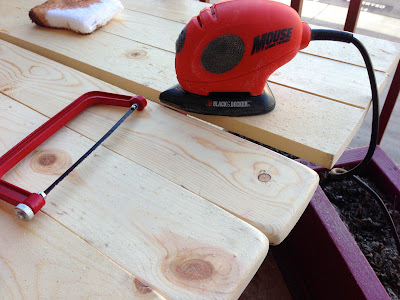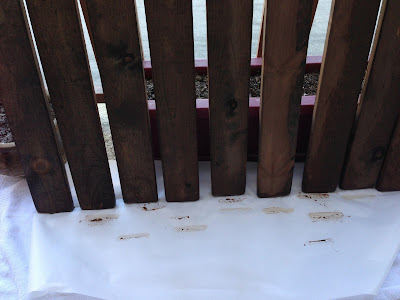My inspiration for this project came from -- where else?-- Pinterest! I happened upon this blog post by Shannon at The Feminist Mystique, and when I saw what she had done with her ho-hum coffee table, I knew I had to do it with mine. Hers was the 3'x4' Lack table; mine is the 3'x4' Hemnes table-- both are from Ikea, and while they would be perfect for certain settings, the minimalist design was a little boring in my living room.
The original Hemnes table:
It's part of a collection of solid pine tables from Ikea. However, it is SO dark and smooth, and so little grain shows through the finish, that it's really pretty indistinguishable from the less expensive particle board furniture pieces that are more common at Ikea.
Now, on to the project!
I was THRILLED with the results of the homemade stain I made from brewed tea, vinegar, and steel wool, but I'll get to that later.
I headed over to Lowe's and started looking at the 1x4 wood boards. I decided on Douglas fir boards, because they were the cheapest ones and, well, this IS an Ikea table. I didn't want to put more money into improving it than I did when I first purchased it. I bought five 8'-0" boards and had the fellow in the back cut them in half for me.
Unfortunately, the fellow didn't cut them EXACTLY in half, and some boards ended up being up to 1/2" longer than others. While the idea was to make a rustic, imperfect table, 1/2" was a little too imperfect. So, my real journey began with cutting these things down to size. Upon the advice of the Ace Hardware man, I decided to use a small hacksaw. We have a decent supply of tools in our garage, but no motorized saws. Well, the hacksaw just didn't cut it. (See what I did there?) It took FOREVER to saw through those boards, and deep into the process, I realized that an old-school rasp was a more efficient option for getting rid of that excess wood.
After the boards were of relatively equal size, I took my rasp to the end edges and started rounding them, following with a good sanding of all surfaces using 120 and then 220 grit sandpaper and my trusty Black & Decker Mouse sander. I was so proud of these boards until I laid them on my table and realized I had rounded the ends a little too much-- I did not like the look AT ALL.
Fortunately, there was enough overhang for me to rasp and sand them back to a shape that was a little more angular, but still slightly rounded. I also rounded the top sides of the boards from top to bottom-- the edges that would be showing once they were attached to the table. These are the re-done ends:
Much better.
Now, for the really fun part -- the staining! When I first went to pick out my materials at Lowe's, I also picked up some steel wool. I had read a few articles online about how to weather or oxidize wood with the product of a chemical reaction that occurs when steel wool dissolves in vinegar. I researched a few variations of the method and finally settled (loosely) on this one by Hillary at The Friendly Home. The steel wool / vinegar solution reacts with the tannins in the wood, creating a stain that can vary in hue and darkness depending on the following:
- the type of wood being used
- the length of time during which the steel wool dissolves in the vinegar
- the number of coats of the "stain"
- the addition of extra tannins to the wood
I chose to use Hillary's method of first brushing the wood with strong brewed tea. I used PG Tips, because I had it in my pantry, and I used about twice the amount of tea specified on the package per volume of water. I probably made about 4 cups of tea, which was WAY more than enough.
Black tea is chock full of tannic acid. Although the wood that I used contains natural tannins that would definitely react with the oxidizing solution, impregnating the wood with strong tea magnifies the reaction substantially. The result is a more rapid and dramatic reaction than would be achieved without applying the tea. If you are a chemistry nerd like I am, you can read more about the science involved in the reaction here.
Meanwhile, I took two big wads of #0000 fine steel wool and tore it into pieces, dropping it into about 3 cups of white vinegar first into a glass bowl covered with Saran Wrap, but eventually transferred it to a plastic bucket with a lid. (The smell. OMG, the smell.) Some websites stated that glass must be used for this process, but I took a chance with the plastic bucket, and it worked just fine. I steeped my steel wool in the vinegar for approximately 36 hours and then strained it through a chinois, though other people have used coffee filters or cheesecloth. The product looks absolutely disgusting, and it smells even worse!
Before:
After:
Yummy!
You'll probably want to prepare your steel wool / vinegar mixture at the beginning of your project, so that it'll be nice and ready for you when you're ready to apply it to your wood. That is, if you're like me, and preparing the wood takes days. If you're really good with woodworking, you might want to start the mixture a day beforehand.
Anyway, I laid down a large plastic dropcloth and placed the boards on it. Using a cheap foam paintbrush, I painted all sides liberally with the tea and stood them on end (on a dry piece of parchment paper) to dry. The tea doesn't have to dry completely-- it just needs to soak into the wood until the exterior surface of the wood feels mostly dry to the touch.
Now, get ready for a magic show. As you can see in the appetizing "after" photo of the steel wool / vinegar solution, there's not a whole lot of color to it. When you apply it to your tea-treated wood, however, you will be amazed. I was, anyway. I'm a nerd like that. Using another cheap sponge brush, I brushed each board on all sides with the solution and again stood them up to dry. (Be sure to wear gloves when you're staining your wood. My hands and nails looked like a car mechanic's when I was done.) I'd say that it took about 15 minutes for the color to fully develop. Here is a before-and-after shot:
Pretty amazing, right?
I found that I needed only one coat of the solution for my desired color to develop. It was a nice, warm, brown color-- but I had something else in mind. For the life of me, I cannot remember where I read this, but did you know that you can use shoe polish as a furniture wax? I didn't! I had tried a test spot on one piece of wood to see what kind of effect black shoe polish would have over this color, and I LOVED IT! The black deepened and cooled the shade a bit, and it really highlighted the grain. So, after the boards had completely dried, I rubbed a thin layer of black shoe polish (Kiwi Parade Gloss) onto the boards and let it dry. After about 15 minutes, I buffed the boards well, and the time had finally come to apply them to my table!
I chose to screw my boards from the bottom of the table with 1 1/4" wood screws into predrilled pilot holes. I used an electric drill to do this -- I don't even want to imagine doing it by hand! I put one screw into both ends of each board, and ran another line of screws down the center of the table. I was worried about the fact that one of my boards was a little concave, but the screws flattened it out perfectly.
Now, all that was left to do was to apply a couple of coats of Johnson's Paste Wax. (This is really important in "sealing" the wood, especially since black shoe polish was just applied. Also, furniture wax is not the most durable finish for furniture, especially heavily-used surfaces, but this is a rustic table, so I am not too concerned about that.) I used the natural color-- I applied it in a thin layer, let it dry for 15 minutes, and buffed it well with an electric buffer. I repeated this process, and... my table was DONE! (Please ignore the mess -- I had not put away my makeshift "wood shop" before I took these photos!)












